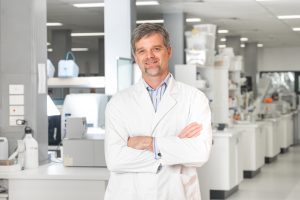You’ve probably seen one if you’ve snorkelled a reef but little do people know that the beautiful feather star and sea-lily could one day be the source of new medicines.
Griffith University scientists Dr Yunjiang Feng, Dr Shahan Khokhar and Associate Professor Rohan Davis have undertaken an in-depth study of the chemical makeup of feather stars and sea-lilies — the first since the 1970s — in an effort to comprehensively document the chemistry and biological activity of these unique sea creatures.
The work aims to help future researchers worldwide in their quest for new natural products and potential drugs from these marine sources.
Their comprehensive review, published on the front cover of the prestigious international journal Natural Product Reports, revealed the chemistry, biology, and taxonomy of more than 50 feather stars and sea-lilies – collectively known as crinoids.
Researchers also highlighted current challenges associated with studying these organisms, and provided insights and directions into how some of these challenges can be overcome, with a particular focus on the structure determination studies of new crinoid natural products.

Associate Professor Rohan Davis at GRIDD.
With only a handful of researchers in the world looking at crinoid chemistry, research leaders Associate Professor Davis and Dr Feng of the Griffith Institute for Drug Discovery (GRIDD), are hoping that these under-investigated marine creatures can be used as a potential source of new and bioactive compounds.
“Traditionally terrestrial organisms have been studied for drug discovery and natural products chemistry, since it was typically a lot easier for someone to go into a forest and collect a plant or mushroom, compared to the marine environment, which up until the 1950s (when SCUBA was invented) was far less accessible,” Associate Professor Davis said.
While marine natural products have only been studied for several decades, they are starting to have an impact on drug discovery.
To date, three marine natural products have been approved as prescription drugs – ziconotide from the venom of the cone snail and two anticancer drugs, trabectedin from the Caribbean sea squirt and eribulin mesylate, which is a derivative of a sea sponge metabolite.
Associate Professor Davis said other marine natural products or their synthetic analogues were in late-phase clinical trials so the future was looking promising for “drugs from the sea”.
Marine organisms – sponges, ascidians, corals and more – make up a substantial component of GRIDD’s NatureBank, a unique drug discovery platform based on natural product extracts and fractions derived from Australian plants and marine invertebrates.
The marine invertebrates are collected and supplied through collaboration with Queensland Museum, while the NatureBank plant samples have been taxonomically identified and supplied by the Queensland Herbarium.
This collaboration between the museum, herbarium and Griffith University was initiated in the early 1990s. Since that time more than 2000 new species of marine invertebrates or plants from the Great Barrier Reef and Queensland rainforests, respectively, have been identified.
Currently there are more than 30,000 different biota samples in NatureBank which can be accessed by researchers worldwide and used to search for new drugs to treat and prevent diseases and conditions such as malaria, African sleeping sickness, cancer, Parkinson’s, schizophrenia, stroke, thrombosis, tuberculosis, HIV and Alzheimer’s.
“One of our main goals at GRIDD is to use the unique NatureBank resource in collaboration with industry, academia and not-for-profits to tackle some of the world’s most devastating disease,” Associate Professor Davis said.
“We hope that one day in the near future natural products from Australian terrestrial or marine samples, will be playing a major role, and having significant impact in the drug discovery and development arena. Finding new drugs from Australia’s natural resources is what NatureBank is all about.”
